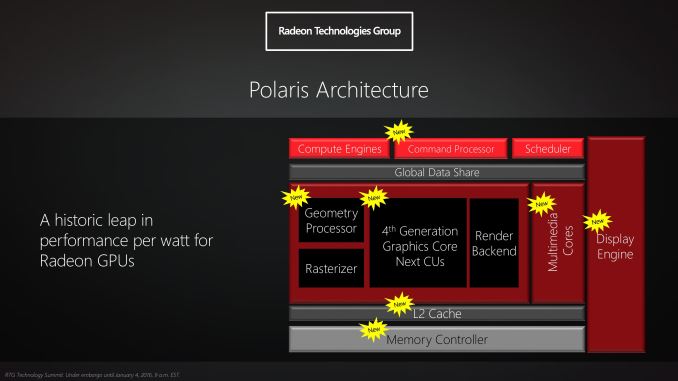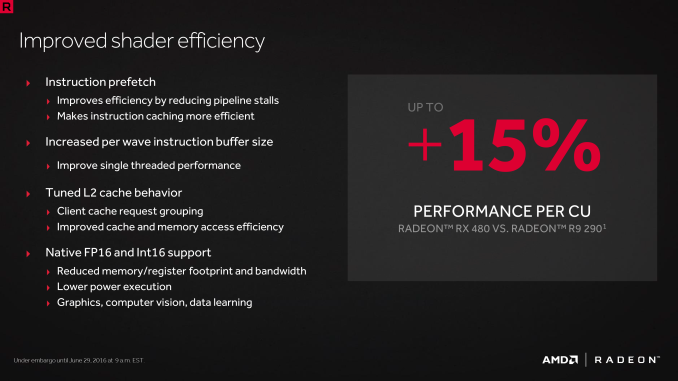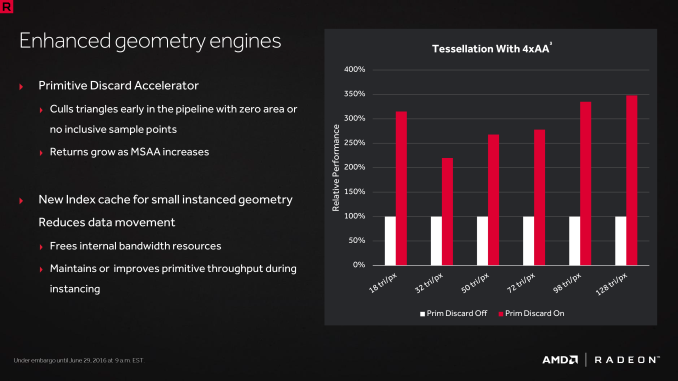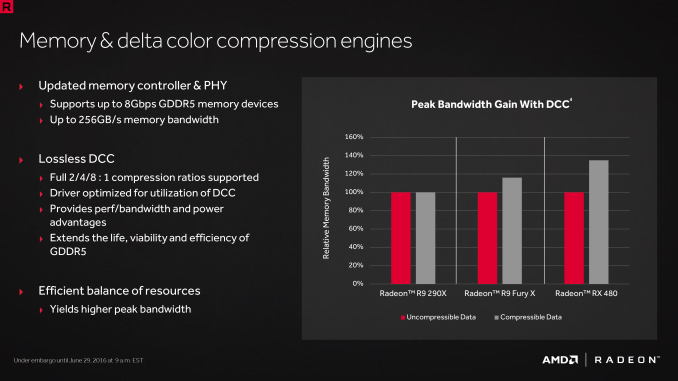The AMD Radeon RX 480 Preview: Polaris Makes Its Mainstream Mark
by Ryan Smith on June 29, 2016 9:00 AM ESTThe Polaris Architecture: In Brief
For today’s preview I’m going to quickly hit the highlights of the Polaris architecture.
In their announcement of the architecture this year, AMD laid out a basic overview of what components of the GPU would see major updates with Polaris. Polaris is not a complete overhaul of past AMD designs, but AMD has combined targeted performance upgrades with a chip-wide energy efficiency upgrade. As a result Polaris is a mix of old and new, and a lot more efficient in the process.
At its heart, Polaris is based on AMD’s 4th generation Graphics Core Next architecture (GCN 4). GCN 4 is not significantly different than GCN 1.2 (Tonga/Fiji), and in fact GCN 4’s ISA is identical to that of GCN 1.2’s. So everything we see here today comes not from broad, architectural changes, but from low-level microarchitectural changes that improve how instructions execute under the hood.
Overall AMD is claiming that GCN 4 (via RX 480) offers a 15% improvement in shader efficiency over GCN 1.1 (R9 290). This comes from two changes; instruction prefetching and a larger instruction buffer. In the case of the former, GCN 4 can, with the driver’s assistance, attempt to pre-fetch future instructions, something GCN 1.x could not do. When done correctly, this reduces/eliminates the need for a wave to stall to wait on an instruction fetch, keeping the CU fed and active more often. Meanwhile the per-wave instruction buffer (which is separate from the register file) has been increased from 12 DWORDs to 16 DWORDs, allowing more instructions to be buffered and, according to AMD, improving single-threaded performance.
Outside of the shader cores themselves, AMD has also made enhancements to the graphics front-end for Polaris. AMD’s latest architecture integrates what AMD calls a Primative Discard Accelerator. True to its name, the job of the discard accelerator is to remove (cull) triangles that are too small to be used, and to do so early enough in the rendering pipeline that the rest of the GPU is spared from having to deal with these unnecessary triangles. Degenerate triangles are culled before they even hit the vertex shader, while small triangles culled a bit later, after the vertex shader but before they hit the rasterizer. There’s no visual quality impact to this (only triangles that can’t be seen/rendered are culled), and as claimed by AMD, the benefits of the discard accelerator increase with MSAA levels, as MSAA otherwise exacerbates the small triangle problem.
Along these lines, Polaris also implements a new index cache, again meant to improve geometry performance. The index cache is designed specifically to accelerate geometry instancing performance, allowing small instanced geometry to stay close by in the cache, avoiding the power and bandwidth costs of shuffling this data around to other caches and VRAM.
Finally, at the back-end of the GPU, the ROP/L2/Memory controller partitions have also received their own updates. Chief among these is that Polaris implements the next generation of AMD’s delta color compression technology, which uses pattern matching to reduce the size and resulting memory bandwidth needs of frame buffers and render targets. As a result of this compression, color compression results in a de facto increase in available memory bandwidth and decrease in power consumption, at least so long as buffer is compressible. With Polaris, AMD supports a larger pattern library to better compress more buffers more often, improving on GCN 1.2 color compression by around 17%.
Otherwise we’ve already covered the increased L2 cache size, which is now at 2MB. Paired with this is AMD’s latest generation memory controller, which can now officially go to 8Gbps, and even a bit more than that when oveclocking.














449 Comments
View All Comments
fanofanand - Thursday, June 30, 2016 - link
Amazing that you have managed to purchase a card no one has for sale. Not Newegg, not Amazon, go ahead and tell us all where you were able to procure an unreleased card?catavalon21 - Wednesday, July 13, 2016 - link
"2 RX 480s probably beat a single 1070 while consuming twice the power"Actually, very close to double the power in a particular gaming selection (87% more was their assessment)
http://www.hardocp.com/article/2016/07/11/amd_rade...
slickr - Thursday, June 30, 2016 - link
The only people who care and cared about power consumption, whether its 150W or 170W were/are the paid and bought for shills who write for Nvidia and who commit fraud and scam against their readers, they are committing crimes.Nvidia won because of the shills.
D. Lister - Thursday, June 30, 2016 - link
You get it man, you've got it all figured out! Yours is the level of comprehension that lesser men like myself strive for all their lives, and still fall short by miles. To hell with trivialities like hardware components, a mind like yours should be tackling questions like "the meaning of life" and whatnot.fanofanand - Thursday, June 30, 2016 - link
A+ on the hyperbole (is your name an homage to Dean Lister, the MMA fighter?) but his original statement isn't entirely wrong. Few desktop users will notice the difference between 150 watts and 170 watts. I don't know about the tinfoil hat stuff, but the original premise isn't completely invalid.D. Lister - Friday, July 1, 2016 - link
"is your name an homage to Dean Lister, the MMA fighter?"Actually it is an homage to "David 'Dave' Lister", from the "Red Dwarf" books. :)
"Few desktop users will notice the difference between 150 watts and 170 watts. I don't know about the tinfoil hat stuff, but the original premise isn't completely invalid."
The thing is, no one terribly cares for the 480 slightly overshooting the TDP. The thing they're complaining about is AMD's choice to stick on a 6-pin connector on the ref card, instead of an 8-pin one, which forces the card to compensate by over-drawing from its slot. Nonetheless, I was really more concerned about the tinfoil hat stuff.
andrewaggb - Thursday, June 30, 2016 - link
Nah, power consumption is a big deal to some people. I agree that 150W vs 170W is nothing, but pulling an extra 100W or more for the same performance isn't great. It's heat that ends up in the room with you, it's bigger heatsinks or faster fans etc.In laptops power consumption is everything. AMD needs to get it under control, simple as that. I think the RX 480 and 470 will be fine, but if they are already pulling 1070 numbers what will Vega pull? It'll probably use HBM2 and get power savings there, but what about the GPU itself?
jayfang - Thursday, June 30, 2016 - link
Nice, something that makes sense to replace my HD 6850 with.Intel / AMD please step up - still rocking i5-2500K
drgigolo - Thursday, June 30, 2016 - link
Where is the GTX 1080 review? Or 1070 for that matter.cocochanel - Thursday, June 30, 2016 - link
You didn't read all the comments. It's coming out in a few days.